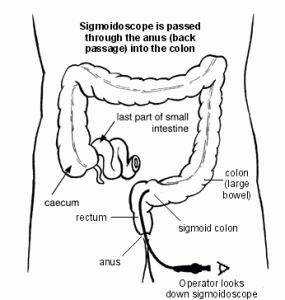Sigmoidoscopy is a procedure where a doctor into the rectum and sigmoid colon, using an instrument called a sigmoidoscope. At Saint Gabriel Hospital this procedure is done by our trained Internist/gastroenterologist.

What is a sigmoidoscopy?
The sigmoid colon is the final portion of the bowel that is joined to the rectum. A sigmoidoscope is a small tube with an attached light source about the thickness of your finger. A doctor inserts the sigmoidoscope into the anus and pushes it slowly into the rectum and sigmoid colon. This allows the doctor or nurse to see the lining of the rectum and sigmoid colon. The procedure is not usually painful but it may be a little uncomfortable.
There are two types of sigmoidoscope that can be used. The most commonly used is the flexible sigmoidoscope. This instrument allows your doctor to see around bends in the colon. A flexible sigmoidoscope gives doctors a better view of the lower colon and usually makes the examination more comfortable.
The rigid sigmoidoscope has generally been replaced by the flexible version and is now used less often. It allows your doctor to look into the rectum and the bottom part of the colon but it does not reach as far into the colon as the flexible sigmoidoscope.
What is a sigmoidoscopy used for?
Sigmoidoscopy can be used to investigate the cause of bleeding or pain from the back passage. Your doctor may also suggest this test if you have various other bowel-related symptoms. The test can also look for evidence of cancer or inflammation of the rectum and lower colon. Sigmoidoscopy can also be used to remove polyps (small fleshy growths that can be found in the colon) and take samples of tissue (biopsy) for analysis. This is done by passing a thin grabbing instrument down a side channel of the sigmoidoscope.
What should I do to prepare for sigmoidoscopy?
For a doctor to get a clear view, your rectum and lower colon need to be empty of stools .You should be given detailed instructions on how to clear your bowel before you have a sigmoidoscopy. This is usually by taking powerful laxatives for a day or two, or by using one or two enemas prior to the procedure.
The test itself
This test takes just a few minutes. Usually you do not need an anaesthetic or sedation. You wear a hospital gown so that the lower half of your body is exposed. You will be asked to lie on your left side with your knees drawn up toward your chest.
First the doctor or nurse will gently insert a gloved and lubricated finger (or fingers) into the rectum to check for blockage and to widen the anus. Then the sigmoidoscope will be inserted and gently pushed further into the rectum and colon. Air is gently pumped through the sigmoidoscope to help viewing. This can cause you to feel bloated and uncomfortable and give you an urge to ‘move your bowels’ (defecate). As the sigmoidoscope is slowly removed, the lining of the bowel is carefully examined.
A small sample (biopsy) of bowel lining may be taken during the procedure. The sample is sent to the laboratory to be looked at under the microscope. It may also be tested for various conditions that can affect the bowel.
Are there any side-effects or complications from a sigmoidoscopy?
Most sigmoidoscopies are done without any problem. Some people have some crampy pains and excess wind after the procedure.
You may also get leakage of liquid accompanied by gas for up to 24 hours after taking the last dose of laxatives: you should arrange your work/social activities following a sigmoidoscopy with this in mind.
Occasionally, the sigmoidoscope causes some damage to the rectum or colon. This may cause bleeding, infection and, rarely, perforation of the colon. If any of the following occur within 48 hours after a sigmoidoscopy, consult a doctor immediately:
- Severe abdominal pain.
- Bloody bowel movements or rectal bleeding.
- Fever.
Screening for colorectal (bowel) cancer with flexible sigmoidoscopy
It has been proposed that a routine flexible sigmoidoscopy test should be offered to all older adults. This is because most bowel polyps and colorectal cancers develop in the rectum, sigmoid colon or lower descending colon. Colonic (bowel) polyps are small benign (non-cancerous) growths on the inside lining of the colon or rectum. They are common in older people. They usually cause no symptoms or problems. However, if a polyp is found, it is usually removed. This is because there is a small risk of a colonic polyp developing into a bowel cancer after several years.
The results of a large UK research study were published in 2010. The study found that people who had one routine flexible sigmoidoscopy between the ages of 55 and 64 had a reduced risk of developing colorectal cancer by about a third. This was because any polyps that were found during the test were removed. Also, the test can detect early colorectal cancers that have not yet caused symptoms.










